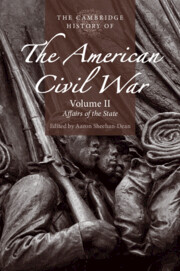Book contents
- The Cambridge History of the American Civil War
- The Cambridge History of the American Civil War
- The Cambridge History of the American Civil War
- Copyright page
- Contents
- Contributors to Volume II
- Note on the Text
- Part I Causes
- Part II Managing the War
- Part III The Global War
- Part IV Politics
- Index
- References
Part IV - Politics
Published online by Cambridge University Press: 11 October 2019
- The Cambridge History of the American Civil War
- The Cambridge History of the American Civil War
- The Cambridge History of the American Civil War
- Copyright page
- Contents
- Contributors to Volume II
- Note on the Text
- Part I Causes
- Part II Managing the War
- Part III The Global War
- Part IV Politics
- Index
- References
Summary
On May 14, 1860, New York’s Harper’s Weekly published a double-page lithograph, depicting eleven “Prominent Candidates for the Republican Nomination at Chicago” just a few days before the party convention. The artist arranged the portraits in two groups of five on the right and left, with New York’s William H. Seward occupying the central place. A past senator and governor, Seward was a strong-minded abolitionist and one of the early architects of the Republican party. Many felt that the nomination was his to lose. To Seward’s left were five men in three rows: Missouri’s Edward Bates, New Jersey’s Alexander Pennington, Ohio’s Salmon P. Chase, transplanted Californian John C. Frémont, and Abraham Lincoln, of Illinois. Frémont had been the Republican standard-bearer four years before, but this time around he was not seen as a likely choice. Chase, on the other hand, had a substantial reputation as an ardent Radical and a leading Republican. The fairly moderate Lincoln was also a serious possibility, although he lacked the national stature of Seward or Chase.
- Type
- Chapter
- Information
- The Cambridge History of the American Civil War , pp. 367 - 544Publisher: Cambridge University PressPrint publication year: 2019



